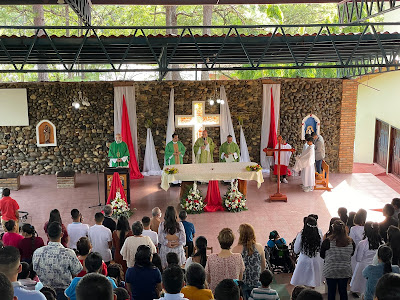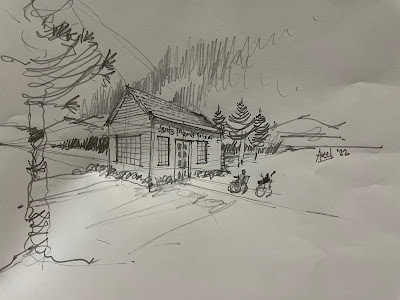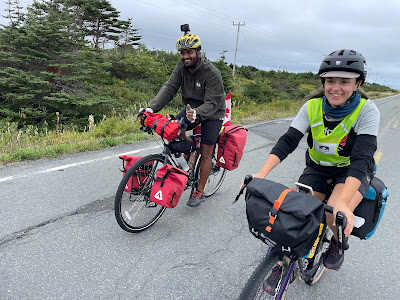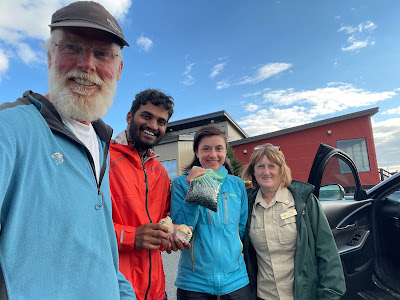I have been coming to NPH since 2012, charged with helping
design medical facilities and a visitor center to host incoming medical
brigades on this 2,200-acre ranch 40 km northeast of Tegucigalpa. To make the ten-year story short, I served to
assist Holy Family Surgery with facility needs, now known as One World Surgery, supporting their
mission providing clinical care to those in need. Along this journey, I fell in love with the
mission of NPH, caring for children in challenging familial circumstances, raising
them as a family without adoptions in this decidedly peaceful, caring rural environment.
In 2013, I became padrino (godfather) to Axel David Quintero
Padilla, age 14, my “tocayo” (people of the same name) since we share the name
“Axel.” Today, Axel is studying Architecture at the University.
I try to return at least once a year to visit Axel and
the other pequeῆos, as well as
check in on progress or projects at One World Surgery (see Building Brick By Brick). This visit was different. I joined a small group of other donors and
godparents, along with two teenage visitors from South Carolina, solely to
visit and participate in ranch activities.
The highlight was to be the rite of passage for 15-year-old boys and
girls making the first step into adulthood, called quinceaῆero.
And what, then, of this incredible day, Saturday, November 19, 2022?
Walk-about
As has been my custom, I rise early and take a walk into the mountains around the ranch before breakfast. This morning, Stephanie Pommier, the Executive Director of the Minneapolis office for NPH, joined my hike around the ranch, covering some five to six miles. Seeing the piney hills and the broad expanse of the valley below in the quiet morning light is special, accompanied by occasional birdsong and flowers.
 |
| Stephanie wandering the piney woods on the mountaintop |
She had never seen the hidden corners of the ranch on her previous visit, so it pleased me to share my regular experience. We saw a John Deere tractor distributing silage to the dairy herd, the possible gift of a farmer/donor known to Stephanie, serving well the donor's intent.
 |
| The John Deere Breakfast Wagon for the dairy herd (Photo: Stephanie Pommier) |
Axel Draws
Following the hike, as I finished up my breakfast, Axel
showed up, having taken the bus from Tegus following a University examination
the evening before. This was to be our
one day together to catch up. However, I
wanted to bring my drawing skills to the pequeῆos and arranged to host a
drawing class for anyone that wished to do so.
I brought my own supplies: good quality paper, many colored pencils,
charcoal, and even felt tip pens for the students to try. Arranged at a stand-up table in a new
playground area dedicated to special needs children, I demonstrated to 8 pequeῆos
(with another named Axel!) the technique of drawing perspective (3 dimensional)
while Axel translated, verbally and graphically. We drew a simple box to demonstrate how to
make 3 dimensions come alive on a flat, two-dimensional piece of paper, describing
and applying horizon lines, vanishing points, light, and texture. I harbored no expectations, even the
possibility of no one attending since arrangements were made rather late.
 |
| Starting the drawing class! |
It was a great success. Outside on this beautifully sunny day, gathered around the table, I could see the intensity of their efforts and the “aha” moments when they connected the points and lines in a way that bought their box, then a house, to life.
What made me especially proud as a “padrino” was to watch Axel spring into action, demonstrating technique, showing “his boys” how to draw. I watched, marveling at how time has flown by; nine years from boy to man, and now teaching his craft in a way I never really expected or contemplated. He can teach, too, just as I had done with him at age 14, with colored pencils, observed by his roommates in his hogar.
 |
| Axel, in whiteT-Shirt, guiding our |
| students. |
I offered the remainder of my supplies to the boys (the
girls had to leave a bit early), whoever wanted them. Most took a pen and perhaps a pencil and a
piece of paper. Still, one in particular quietly hung around to see what was left and was eager to take the remaining wad of paper, most of the pencils and pens,
with a promise requested by me - a “condition” if you will - that he would draw
at least once a week. I never intend to
monitor that agreement, rather just to plant a seed that might prosper. His demonstrated interest, eagerness, and
intensity, the most noticeable of the group, suggests that a seed has been planted.
Confirmation
Elsewhere on the ranch, certain pequeῆos were preparing to be honored and given divine guidance on their Catholic future at mass. We had mass the day before, celebrating quinceaῆero, a pageantry of elegant red ballroom dresses on the girls, and red shirts, suspenders, and ties for the boys, all of whom displayed a sort of cool boredom at all the fuss. Likely characteristic of this age and mindset.
 |
| Their body language says it all: too cool for 15! |
The mass celebrated their passage into early adulthood, a custom in Central America, followed by an evening of dancing in a majestic pageant, a glittery “ballroom” transformed from the outdoor gymnasium.
 |
| Bailando de la quinceaῆeras |
This mass was different, though, for it was hosted with a rare visit by Cardinal Oscar Rodriguez Maradiaga, Archbishop of Tegucigalpa, within the humble outdoor Iglesia. This is a very big deal, especially for those confirmed. Cardinal Maradiaga had been on the short list of candidates from Central and South America to become Pope when Pope Francis from Argentina ultimately ascended the papacy in 2013.
Now, I am not a religious person, at least in terms of
traditional liturgical practice.
Spiritual, yes. Religious,
no. However, I do appreciate that many
people are religious, and I take a respectful interest in all faiths as a
central cultural norm, curious about their unique rites and rituals. I found, over the years, a great appreciation
for Central American catholic mass, typically accompanied by lively music,
clapping, and warm greetings among worshipers. Frankly, this upbeat aspect was
not always accompanied by a priest demonstrating an equivalent vivacity; rather, they are well practiced in a modestly upbeat version of solemnity.
 |
| Confirmation Mass |
I expected Cardinal Maradiaga to epitomize solemnity – seemed logical. Though I understood little of his actual sermon and homily, he did speak slowly enough that I caught the humor of his message, delivering wisdom of life ahead purposefully to all the pequeῆos through humor and jokes, including audience participation, with an intense yet sincere presentation style. I was impressed. It seemed to me many priests, padres, and pastors I have heard could learn what makes an interesting, compelling presentation.
I was hoping that he would be able to visit the chapel I designed at the surgery center, but as it was Saturday, the key was not available. Axel and I were chatting with Cardinal Maradiaga and Reinhardt Kohler (the founder of NPH) following Mass, as everyone had mostly cleared, to see if there was time enough for a visit. His warmth of delivery at Mass extended into a personal exchange in impeccable English and ended by thanking me for my service to NPH. Quite unexpected!*
Nienke
I met Nienke (Nikki) shortly after I arrived at NPH, as she is a 28-year-old
volunteer from the Netherlands on her second stint to extend research for her Master’s thesis around physical therapy themes. Humble, direct, and passionate about pequeῆos
with special needs, her passion for NPH is clearly evident in her continual
engagement with them. She also knows
Axel.
 |
| On the "secret" rock at sunset, before swimming! |
After Mass, the three of us agreed to hike up to the “secret” rock that Axel and I typically visit, watching as we climbed the sun beginning its colorful descent. Though a bit concerned that the impending darkness would make traversing the slippery rock pathway more treacherous, Nikki had it in her mind to go swimming in the new reservoir.
The ranch gets its water collected and trapped in the
mountain watershed through a network of small check-dams trapping water in minor
creeks, as well as a few larger dam structures impounding a larger body of
water, all connected by pipes to the central ranch water tanks down the
mountain. A newer reservoir was dammed several
years ago in this higher mountain vale, and that was Nikki’s secret spot,
visited typically daily for her solo swim, surrounded as it is by pine
woods.
Axel and I were not about to say no, so she led us to her
“spot” on the shoreline. Axel and I stripped to our civies and, following her
lead, plunged into the stratified, murky water; stratified since the warmer
water was the first few feet of depth, followed by decidedly colder water
below, and murky from the rock sediment so prevalent everywhere in these woods
just below the forest floor. With the
darkening sky, this was an absolutely amazing experience. Peaceful, refreshing,
just plain fun, and a new experience for me at NPH.
We found our way down the mountain in the now deep
darkness, phone lights on, drying out a bit on our way back to the visitor’s dormitory,
San Cristobal. Since the communal
kitchen was soon to close, we hurried with our bowls to gather our dinner and, at Nikki’s suggestion, joined two other visitors to have dinner with the special
needs kids in their hogar, Santa Maria Reyna. Axel also spent his year of service following
high school graduation with the special needs boys.
 |
| Nikki with her special friends, with a staff member looking on |
I have never had much exposure to special needs children, much less adults. For me, there has always been a wall, a hidden barricade, keeping them from my social sphere simply because of their differences. NPH has long had special needs homes for boys and girls, a desperate unmet need in Honduras. I was suddenly placed in a position unfamiliar to me, engaging with people quite disconnected from my own reality. Nikki and Axel showed me how to crash through that wall. Merely observing how Nikki engaged with these pequeῆos was marvelous. But what could I do?
 |
| Reading Curious George to my new friends. |
Read a book to a few of them – Curious George, in Spanish. Soon after, a clipboard with two sheets of blank white paper and a pencil was presented to me. Draw, since one of the pequeῆas likes to draw.
I was stunned – and overjoyed. I connected with her!
It was a start – certainly of her drawing, but more of my
awakening to the reality of their awareness.
I was proud of Nikki for the depth of her care and compassion, for
taking me here to experience this moment, for being able to talk to these
people and know that something, some level of comprehension, was going on within
them and enriching their daily existence.
I was humbled by the staff and their dedication to the special lives of
these people. I appreciated the approach of NPH to seek integration of special
needs into the daily activity of the ranch; even at mass, where their occasional,
random outbursts might elsewhere draw an annoyed frown for the “sacred” disturbance,
is simply accepted as fact as their means of communication. And, I was
proud of Axel for dedicating so much of his later years at NPH to the care of
the special needs boys that continues to this day.
How does one finish, let alone absorb the events of this one
day?
We finished by sitting, the three of us, around the radiant, waning warmth
of a bonfire, talking of life ahead for Nikki and Axel, of companionship and
love, of life and living, of people and mission, under an immense, starry sky.
They walked me back to San Cristobal. I tossed and turned, struggling to sleep,
reflecting on all that happened. All, in
one day.
_____________________________________________________________________
*As a postscript, I ran into Cardinal Maradiaga again in the airport Sunday morning, where he recognized me, we chatted more, and he suggested a future visit to the chapel, which he had heard about when the donors and founders, Peter and Lulu Daly, could be present to visit with him. I hope that can happen for the Daly’s deserve such a visit.
 |
| Cardinal Oscar Rodriguez Maradiaga at the airport greeting and thanking our volunteers |











































